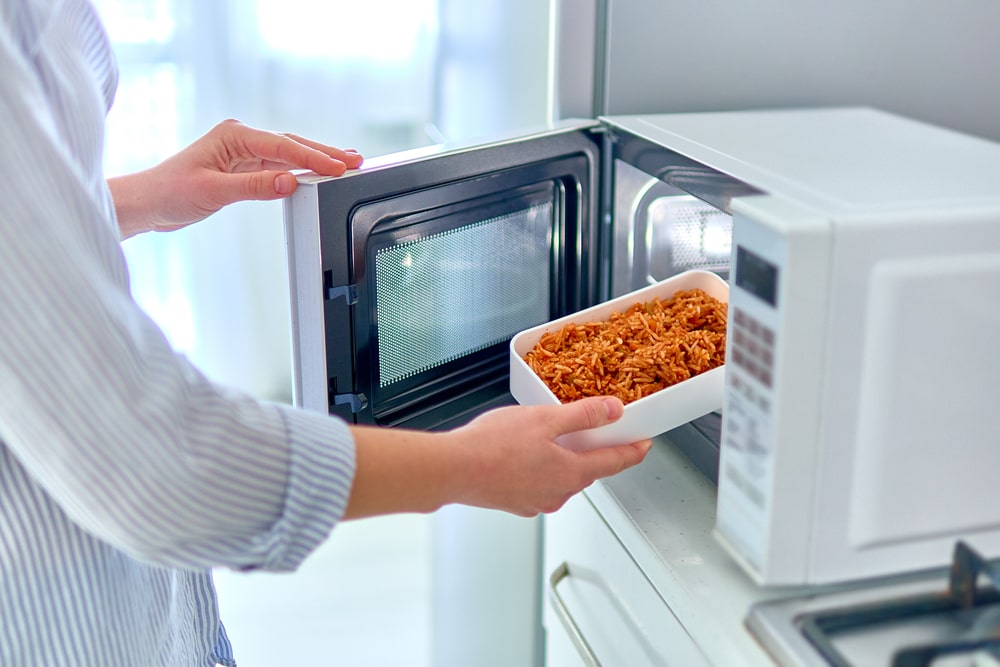Home > Energy Plans > How Much Electricity Does Your Microwave Use?
How Much Electricity Does Your Microwave Use?
Are you wondering how much electricity your microwave uses? Find out here and learn energy-saving tips with Savvy.
Author
Savvy Editorial TeamFact checked

Microwaves have become an essential kitchen appliance, offering convenience and speed in cooking and reheating food. However, have you ever wondered about how much electricity does your microwave use? Understanding how much electricity a microwave uses can help you manage your energy consumption and make informed decisions about energy efficiency.
In this comprehensive Savvy guide, we explore the average electricity consumption of microwave ovens and explore tips for optimising energy efficiency while still enjoying the convenience of a microwave. Discover ways to reduce your electricity consumption and make your microwave usage more sustainable right here.
How much electricity does my microwave use?
The electricity usage of a microwave will vary based on its size and type. Microwave ovens come in different types, wattage options and size capacities, factors which all affect their energy consumption.
Different microwave types
When it comes to microwave types, there are a few options available in the market. Each type has its own characteristics and may offer different features and cooking methods. Here are some common types of microwaves found in Australia:
- Standard microwaves: These microwaves use microwave radiation to heat and cook food. They are the most common type and come in various sizes and power ratings, ranging from 17 litre capacity right up to 35 litre capacity models. On average, standard microwaves consume around 600 to 1,300 watts of power per cooking cycle.
- Grill microwaves: Grill microwaves combine traditional microwave cooking with the addition of a heating element or grill. This allows for browning, grilling, and toasting of food. They provide the convenience of microwave cooking along with added browning or crisping options. The energy consumption of grill microwaves is similar to standard microwaves.
- Convection microwaves: Convection microwaves combine the functions of a microwave and a convection oven with a grill. They use both microwave radiation and hot air circulation to cook food. These microwaves offer faster cooking times and can produce crispy results. Due to the additional convection feature, they typically consume more energy than standard microwaves, ranging from 800 to 1,500 watts.
- Microwave oven combos: Microwave oven combos integrate a microwave with a traditional oven. They provide the versatility of microwave cooking along with the benefits of conventional baking and roasting. These appliances can consume a higher amount of energy due to their larger size and multifunction capabilities.
Factors affecting the cost of using a microwave oven
When considering the electricity cost of using a microwave in Australia, it's important to take into account the following factors:
- Power rating: Microwaves typically have power ratings ranging from 600 to 1,800 watts for combined microwave ovens. Higher-wattage microwaves consume more electricity than lower-wattage ones.
- Usage duration: The length of time you use your microwave will impact its energy consumption. Consider how often you use the microwave and for how long each time to arrive at its total power consumption.
- Capacity: Microwaves come in various sizes, from compact models to larger family-sized units. Larger microwaves may require more energy to heat up their larger interior space.
- Efficiency: Energy-efficient models are designed to minimise electricity usage without compromising performance. Look for microwaves with high energy efficiency ratings or eco-friendly features.
To estimate the electricity consumption of a specific microwave, refer to the manufacturer's specifications for its power rating (in watts) and consider the kilowatt-hours (kWh) consumed per cooking cycle.
This information can help you gauge approximate energy usage. It's worth noting that microwave usage usually accounts for a small portion of overall household energy consumption.
Can I reduce the electricity costs of using my microwave?
To reduce the electricity costs of using your microwave, here are some tips and practices you can follow:
- Opt for energy-efficient models: When purchasing a new microwave, choose an energy-efficient model with a high energy star rating. These models are designed to consume less power while providing efficient performance.
- Choose the right-sized microwave: Select a microwave that suits your needs without being excessively large. Larger microwaves may consume more electricity to heat up their larger interior space.
- Cook in batches: Instead of using the microwave multiple times for small cooking tasks, consider cooking in larger batches to maximise each usage. This reduces the overall number of cooking cycles and helps save on energy costs.
- Use microwave-safe cookware: Utilise microwave-safe containers and cookware that are designed for efficient heat transfer. Proper containers allow food to heat up faster and more evenly, reducing cooking time and energy usage.
- Prep and defrost efficiently: Plan ahead and thaw frozen food items in the fridge or using other thawing methods before using the microwave. This reduces the time required for defrosting in the microwave.
- Avoid overcooking: Be mindful of cooking times and avoid overcooking food in the microwave. Cooking food for longer than necessary consumes more electricity without providing any additional benefit.
- Clean and maintain your oven regularly: Keep your microwave clean and well-maintained. Regular cleaning ensures optimal performance and prevents any issues that might affect energy efficiency.
- Take advantage of preset functions: Many microwaves come with preset cooking functions tailored to specific food items. Utilise these functions to minimise cooking time and optimise energy usage.
- Monitor standby power: Microwaves often consume a small amount of electricity even when not in use. Consider unplugging the microwave or using a power strip with an on/off switch to completely cut off standby power.
By adopting these energy-saving practices, you can reduce the electricity costs associated with using your microwave while still enjoying the convenience it provides.
How do I calculate how much an electrical appliance costs to run?
To find out how much an appliance costs to run, follow these steps:
- Identify the power rating: Locate the power rating of the appliance, typically expressed in watts (W) or kilowatts (kW). You can find this information on the appliance itself or in the user manual.
- Determine the usage time: Estimate the number of hours the appliance operates per day or week, considering both active usage time and standby power consumption.
- Convert to kilowatt-hours (kWh): Multiply the power rating (in kW) by the number of hours of usage to calculate the energy consumption in kilowatt-hours (kWh).
- Find the electricity tariff rate: Check your electricity bill or contact your energy provider to determine the rate per kilowatt-hour (kWh) of electricity consumed which is applicable to your energy plan.
- Calculate the cost: Multiply the energy usage (in kWh) by your electricity tariff rate (in dollars per kWh) to find the cost of running the appliance for the specified time.
For example, let's say you have an appliance with a power rating of 1.5 kW, and you use it for 3 hours a day. If your electricity tariff rate is $0.25 per kWh, the calculation would be:
1.5 kW x 3 hours = 4.5 kWh x $0.25 = $1.125.
By performing these calculations, you can estimate the cost of running an appliance based on its power rating, usage time, and the electricity tariff rate. This information helps you to make informed decisions about energy usage and effectively manage your electricity bills.
Which other household appliances use the most electricity?
These commonly found household appliances are responsible for a significant portion (up to 90%) of your home's energy consumption:
- Fridges and freezers: Outdated models or those with low energy ratings can consume a considerable amount of electricity. Opt for energy-efficient alternatives to decrease power usage and save on electricity costs.
- Reverse-cycle air conditioners: These appliances are known for their high energy consumption. Choose energy-efficient models with intelligent features like programmable timers, inverter technology, and zoning capabilities to minimise energy usage.
- Pool pumps and spa heaters: Pool pumps and spa heaters are notorious for their significant energy consumption. Reduce power usage by switching to energy-efficient pool pumps equipped with variable speed options and built-in timers. Additionally, consider solar-powered heaters or heat pumps to reduce electricity consumption. Using a controlled load tariff for the pool filter and heater can further decrease overall energy costs.
- Water heaters: Explore more energy-efficient options such as heat pumps or solar water heaters to minimise energy consumption for heating hot water.
- Washing machines and clothes dryers: Opt for energy-efficient models with advanced features like load sensors, eco modes, and moisture sensors in clothes dryers to optimise energy consumption.
- Dishwashers: Look for energy-efficient dishwashers with half-load options, eco modes, and delayed start functions to minimise power usage.
- Ovens and stovetops: Select models that heat up quickly, distribute heat evenly, and offer features like convection cooking or self-cleaning functions.
- Computers and office equipment: Utilise power-saving features like sleep mode, and remember to turn them off when not in use. Choose energy-efficient devices with a minimum three-star rating.
By making informed choices and opting for energy-efficient alternatives when it comes to these household appliances, you can effectively reduce overall energy consumption, lower electricity bills, and contribute to a more sustainable future.
Helpful energy guides
Compare energy plans
Disclaimer:
Savvy is partnered with Econnex Comparison (CIMET Sales Pty Ltd, ABN 72 620 395 726) to provide readers with a variety of energy plans to compare. We do not compare all retailers in the market, or all plans offered by all retailers. Savvy earns a commission from Econnex each time a customer buys an energy plan via our website. We don’t arrange for products to be purchased directly, as all purchases are conducted via Econnex.
Any advice presented above is general in nature and doesn’t consider your personal or business objectives, needs or finances. It’s always important to consider whether advice is suitable for you before purchasing an energy plan. For further information on the variety of energy plans compared by Econnex, or how their business works, you can visit their website.










